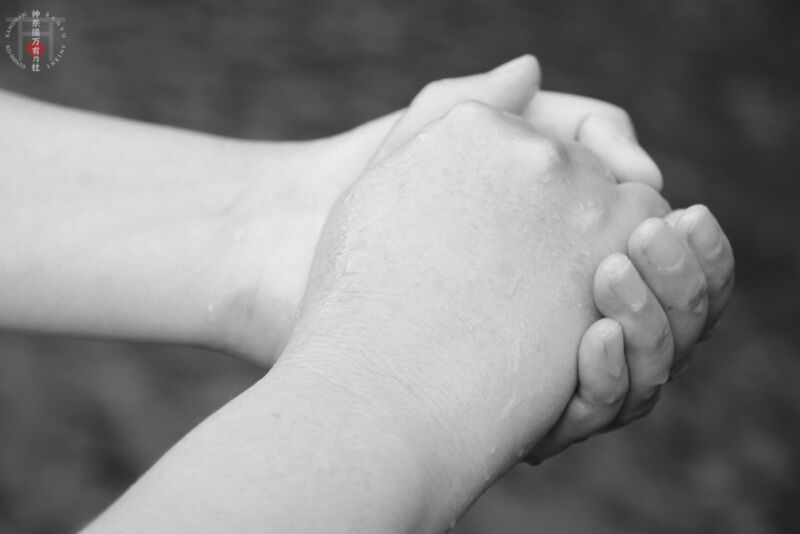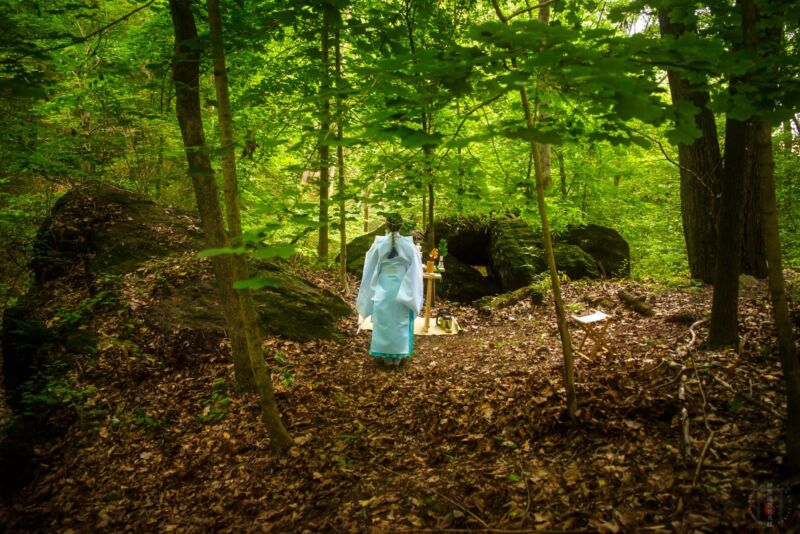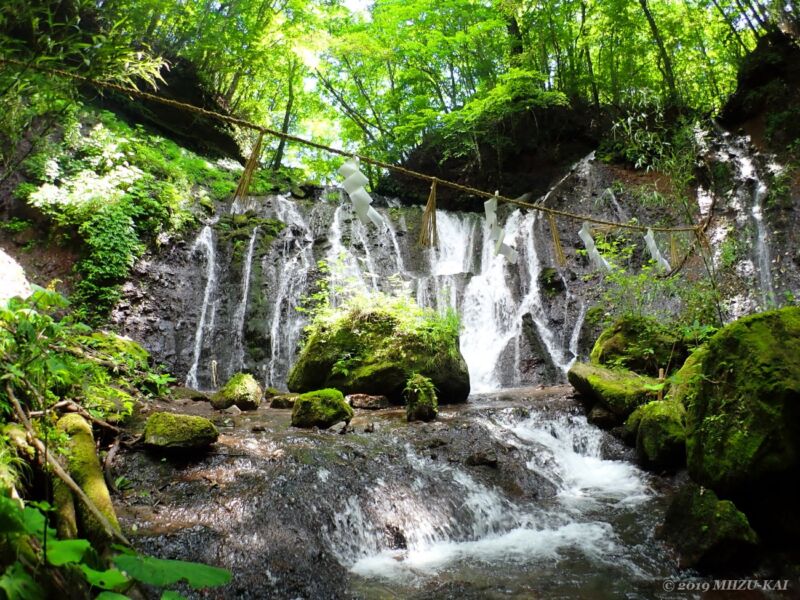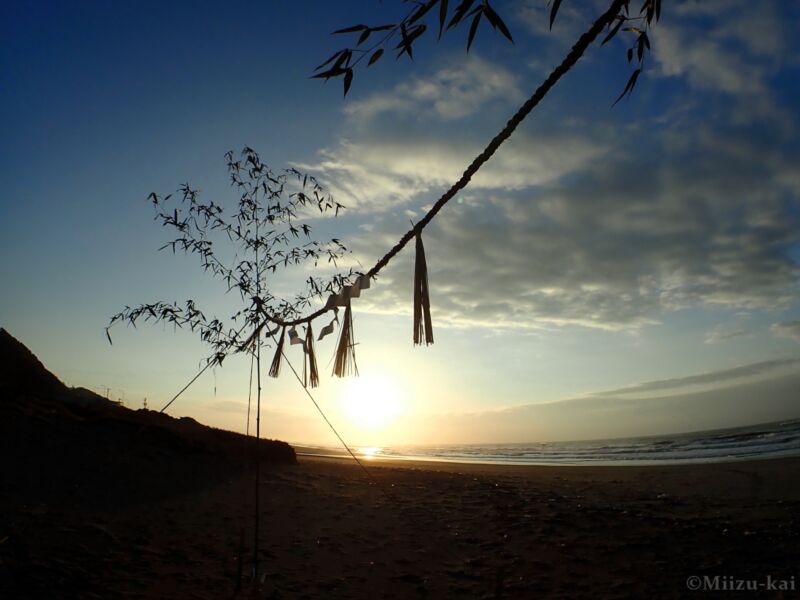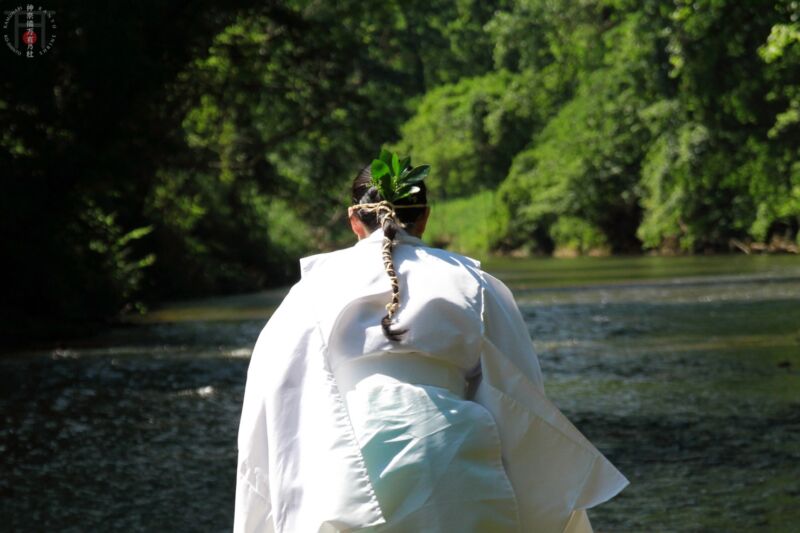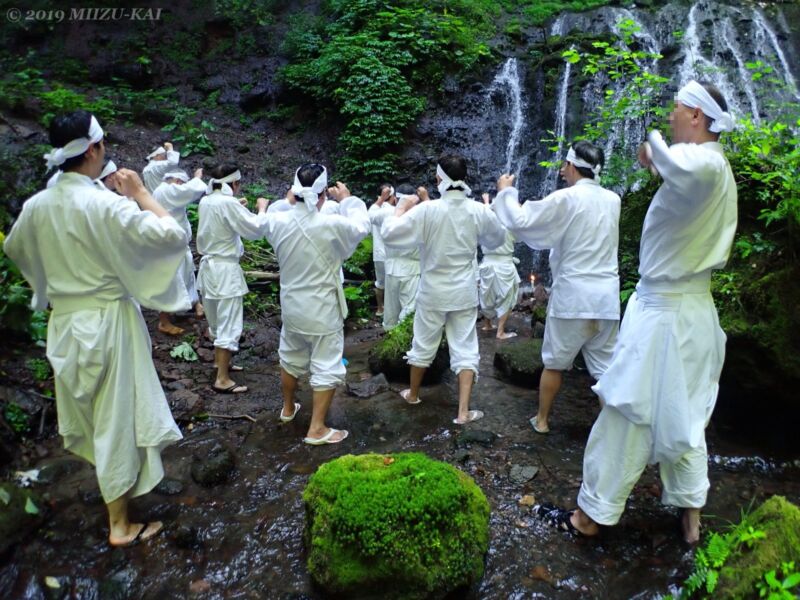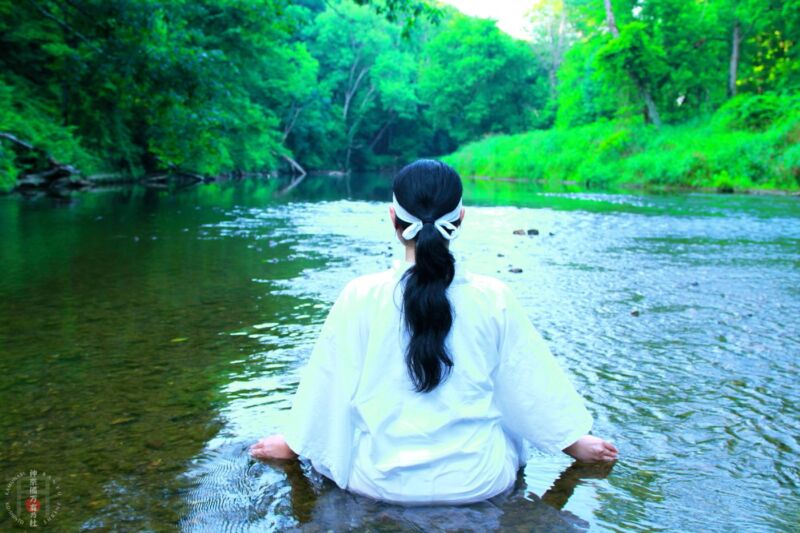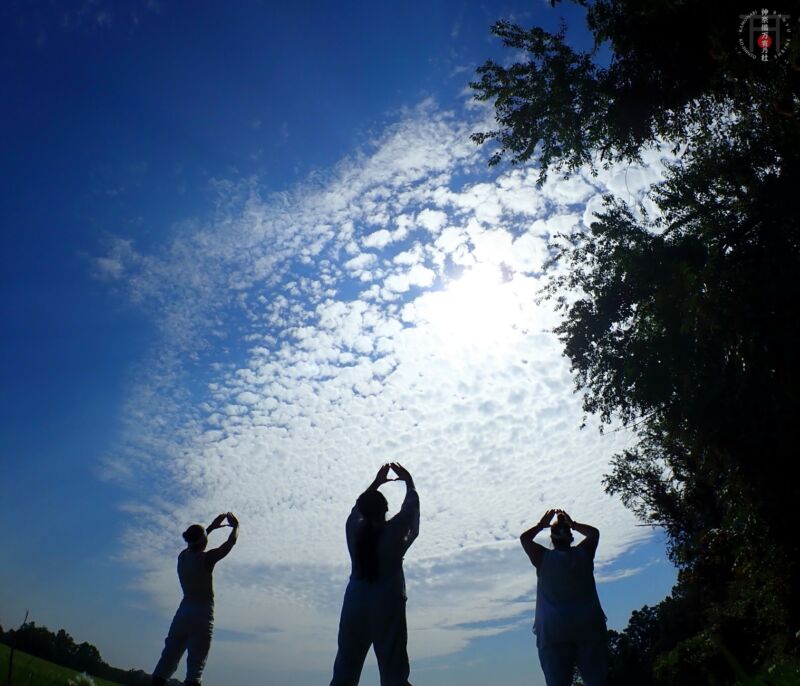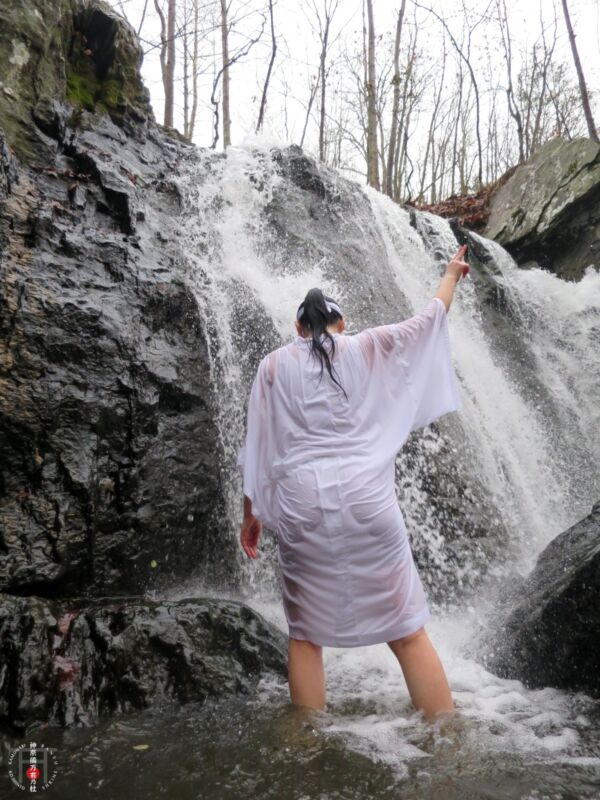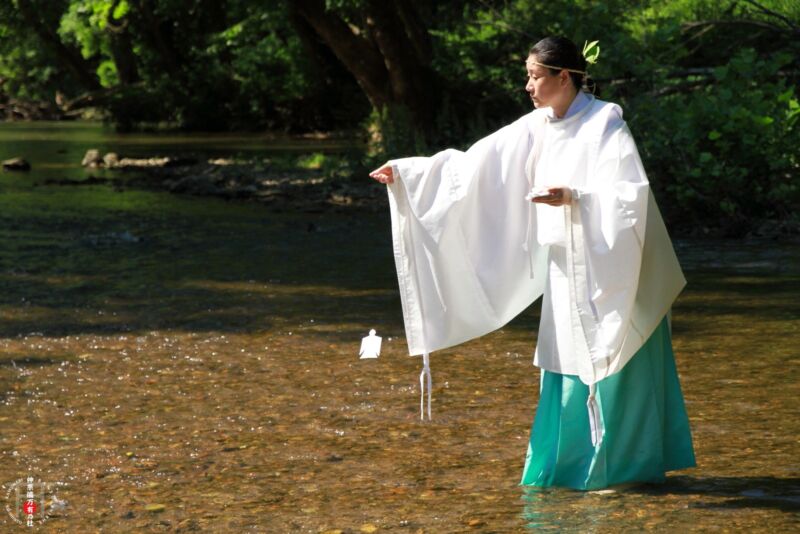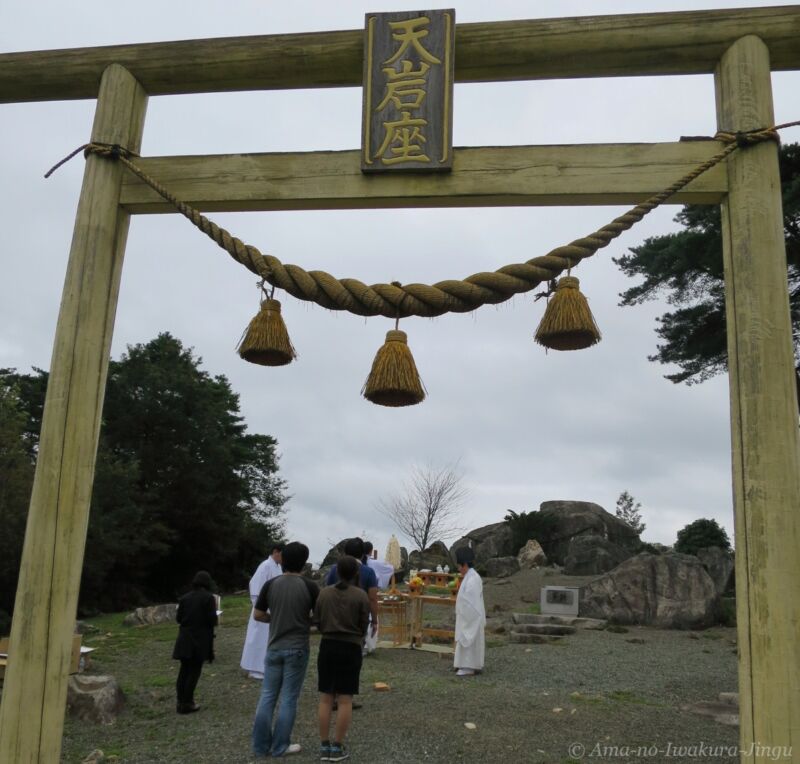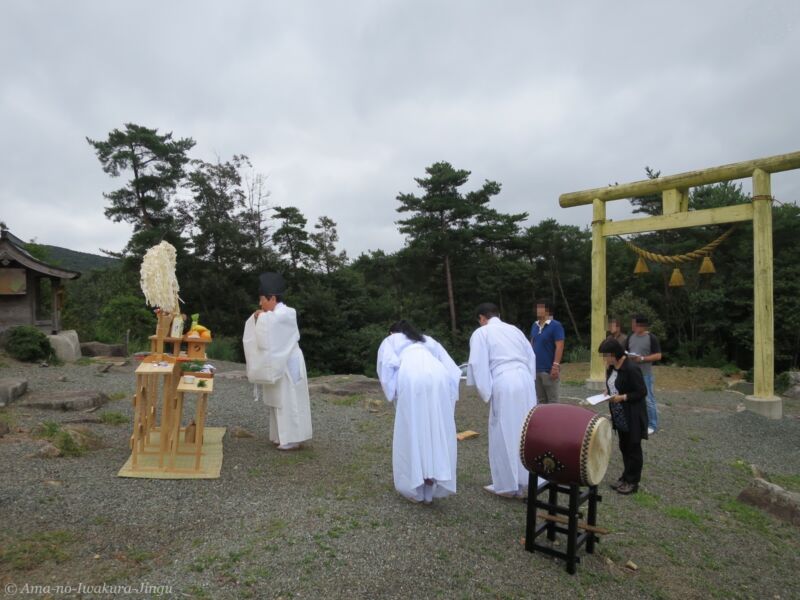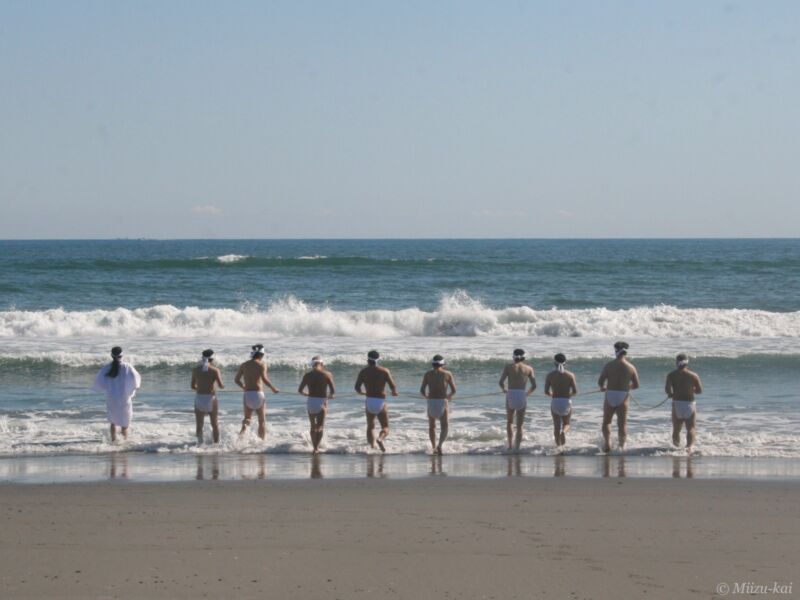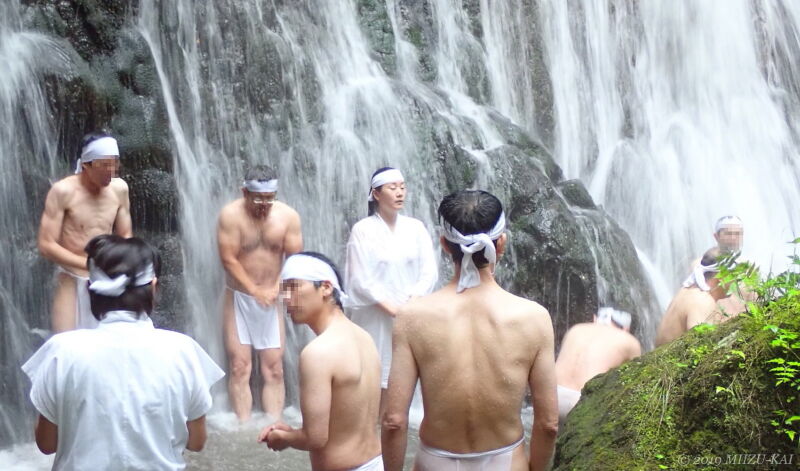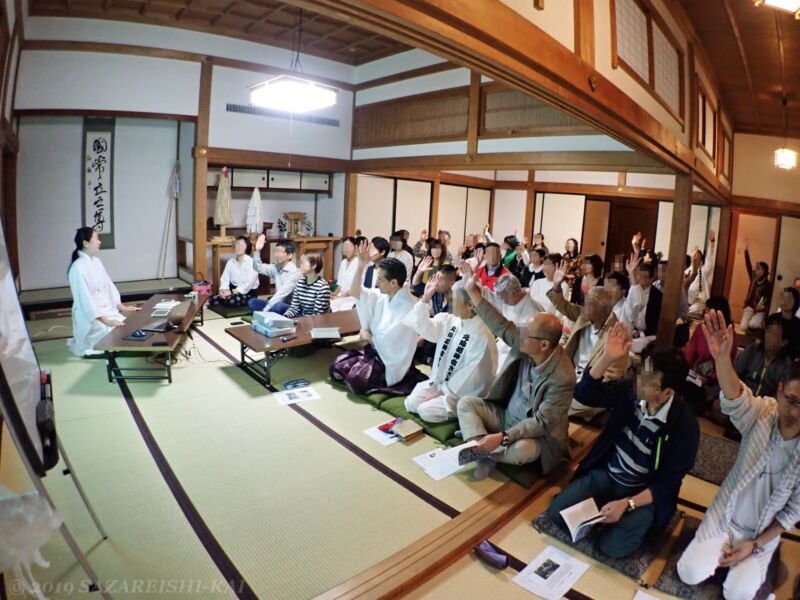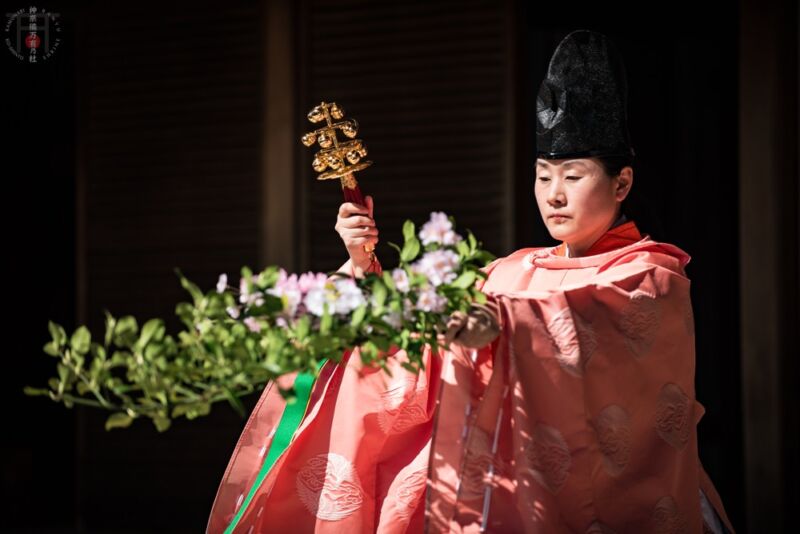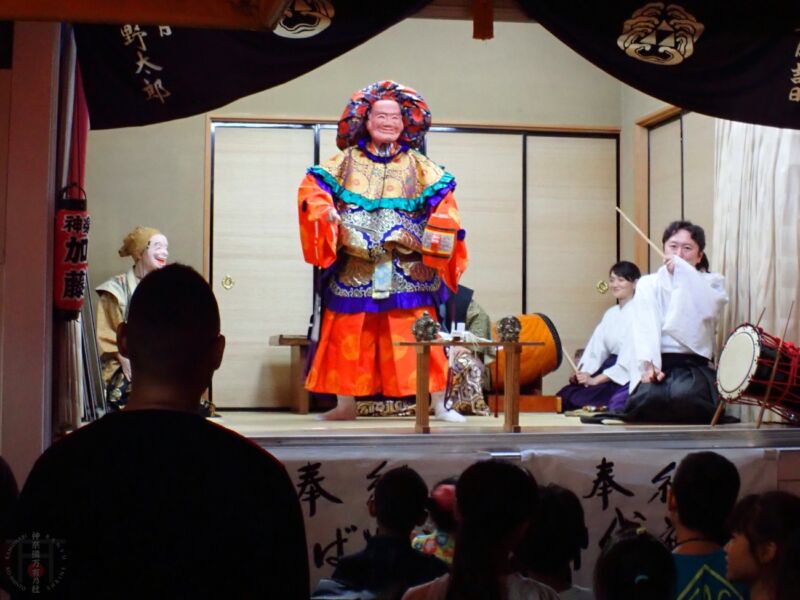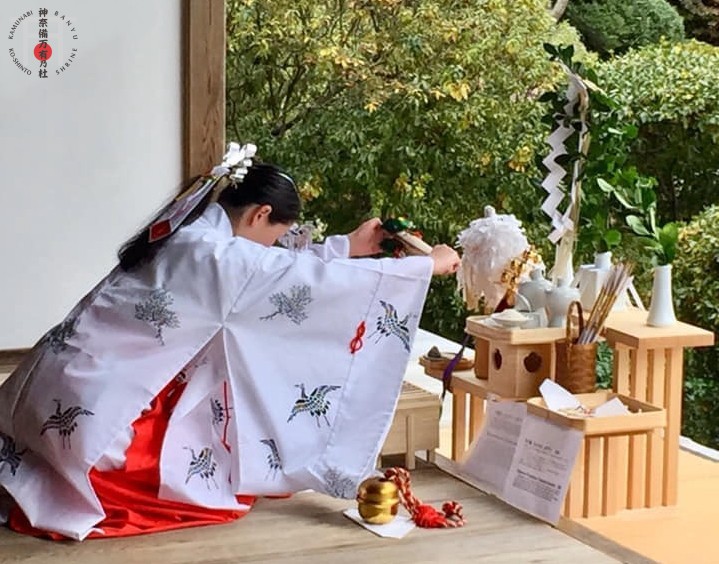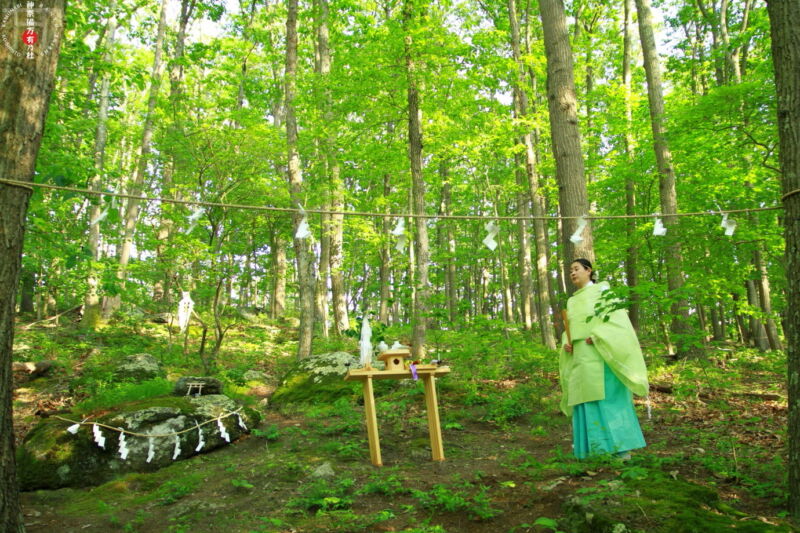
4) Could you tell us something about your shrine Kamunabi-Ban’yu Ko-shinto Shrine? Also what is the relation to the Ama-no-iwakura Jingu?
Kamunabi Banyu Ko-Shinto Shrine by the ancient Himorogi style since prehistoric Jōmon period enshrines the sacred forest, rocks and trees located behind my house in my private property, to present respect, appreciation and awe to glorious virtue of Kami (deities) in great nature.
The sunrise peaks at the top of the sacred forest is truly awe-inspiring. When visiting, this Ko-Shinto shrine responds by clearing the clouds, gusting the wind in woods, merrily talking trees, and their dancing falling leaves. The lively energy of vivid green moss over the sacred rocks stays throughout the year and never withers. The sacred rocks and trees reflecting the sunset are breathtakingly beautiful. The graceful full moon light brightly shines on the Norito liturgy when reciting it in the sacred forest.
Many kinds of beautiful animals live in this sacred site, such as the Kishu dog, descedent of the Japanese wolf, which runs and guides visitors, coywolf (Eastern coyote), fox, deer, squirrel, eagle, hawk, wood-pecker, owl, northern cardinal, frog, ladybird, dragonfly and so on.
This shrine is not open to the public as it is Kinsoku-chi (taboo land) within the bounds of this sacred land, yet can be visited by reservation for private ceremony/blessing and by Shinto class students, when there is not severe snow.
[ HISTORY ]
The shrine was established four years after Rev. Kuniko Kanawa humbly received the Shinto priestess certificate in September 2015 from Ama-no-Iwakura Jingu, the independent Shinto shrine in Hiroshima Prefecture. In the first year of the Reiwa Era, Kamunabi Banyu Ko-Shinto Shrine is now officially titled by rank promotion of the priestess, to preserve and pass universal Ko-Shinto spirituality to the next generation throughout the world. This is an independent Ko-Shinto shrine site, not the American branch of Ama-no-Iwakura Jingu.
Kamunabi: Sacred nature sites where Kami (deities) dwell. The barrier between Toko-yo (eternal spirit world) and Utsushi-yo (physical world). Taboo land.
Ban’yū: All matters / phenomenon existing in the universe
Mori: Sacred nature area to invite Kami to descend. Symbolizes Kami itself.
(related poems can be found in Man’yōshū: Collection of Ten Thousand Leaves – The first Anthology of Japanese poetry)
[ ENSHRINED KAMI ]
Ame-no-minakanushi-no-kami : Deity emerged at the center of the universe
Takami-musuhi-no-kami : Deity of centrifugal force of the universe’s generation/production
Kami-musuhi-no-kami Deity of centripetal force of the universe’s generation/production
Ame-no-tokotachi-no-kami : Deity of the sky constantly establishing
Kuni-no-tokotachi-no-kami : Deity of the Earth constantly establishing
Amaterasu-Oomikami : Sun deity
Tsukuyomi-no-mikoto : Moon deity
Oo-haraedo-no-Ookami : Great deities at magnificent purification sites
Maryland Ubusuna-no-Ookami : Great guardian deity dwelling in the state of Maryland
Ooguchi-Makami : Japanese wolf deity, who once inhabited all of Japan and guided the path for Yamato-Takeru-no-mikoto in the deep mountain
* Other Kami can be called down temporarily by Koushin-no-gi, depending on the ceremony
[ SHINSHI (DIVINE MESSENGER) ]
Introducing our special Shinshi divine messenger among many other wild lives in Kamunabi Banyu Ko-Shinto Shrine. Kishu dog is well known as an excellent hunter in the forest, as they are the direct descendants of Japanese wolf known as Ooguchi-makami (Wolf Kami). Its history can be found in Japanese folklore.
One autumn in the Edo period, the boar hunter Yakurō Mine happened to find the wounded wolf in a deep mountain so he treated her. As she kept following him, Yakurō smiled and said goodbye by joking that she would one day give him one of her puppy wolves after she recovered.
The following spring, after totally forgetting this event, he heard a puppy outside his house. He found the wolf’s puppy facing him right by the door. He figured it was the mother wolf repaying his kindness. She kept her promise.
This wolf puppy later became a great hunting buddy for Yakurō, the ancestor of Kishu dog. This piece of folklore can be seen in this Anime.
Kishu dogs are well known for being white, however they are originally colored, just like wolf’s fur coloration, as seen in our Shinshi especially around her straight tail. Her motions are more like a wolf than a dog.
The hunting Kishu dog is very cautious, naturally smart, understands human language, senses the atmosphere, is remarkably brave, and protects family regardless of risking their lives, and they are swift even in steep mountains.
Most importantly, the wolf dog has the greatest ability as a divine messenger to find and guide to sacred sites. She belongs to the forest. She shows how to live in great nature.
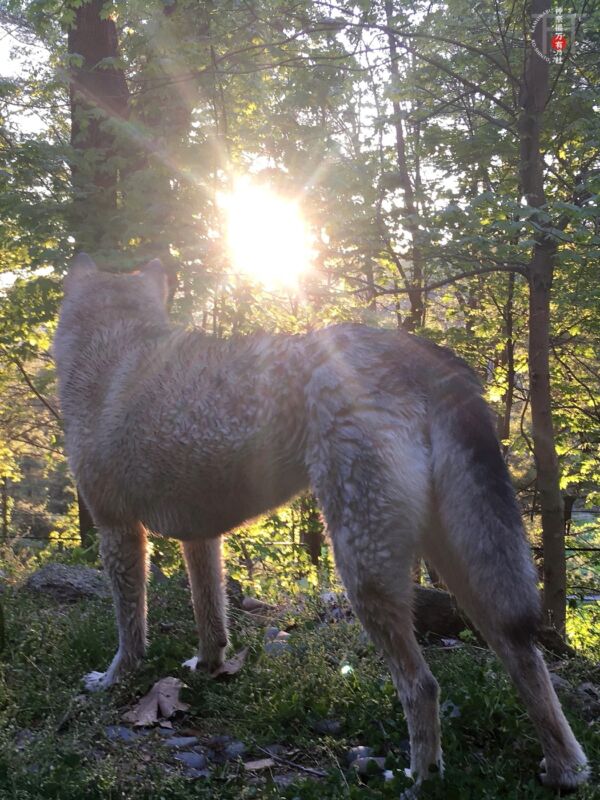
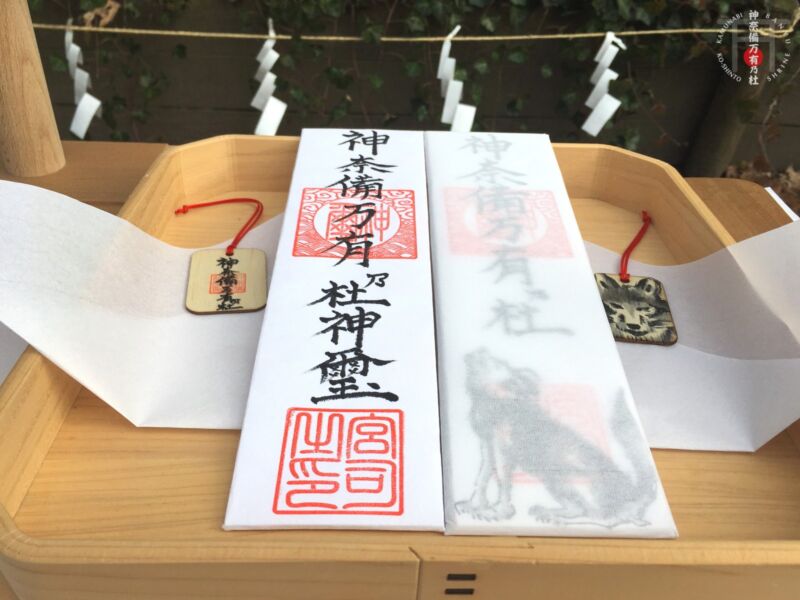
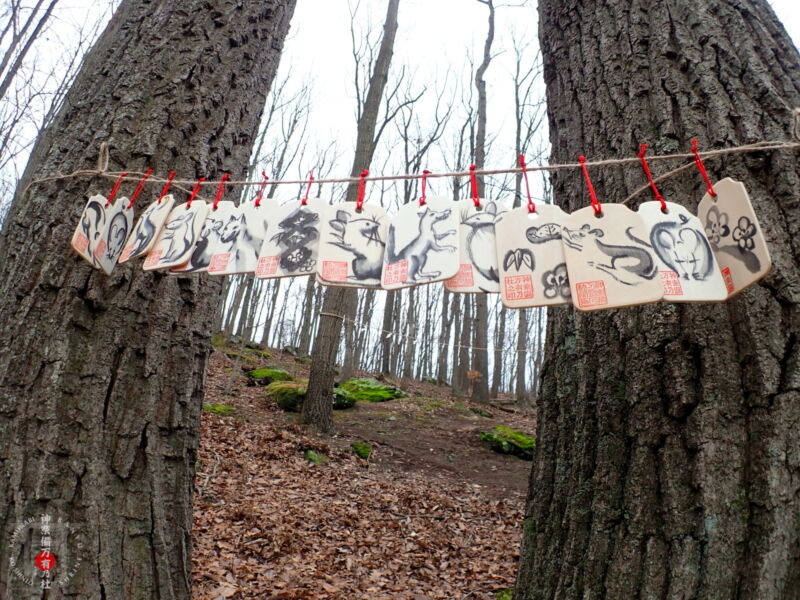
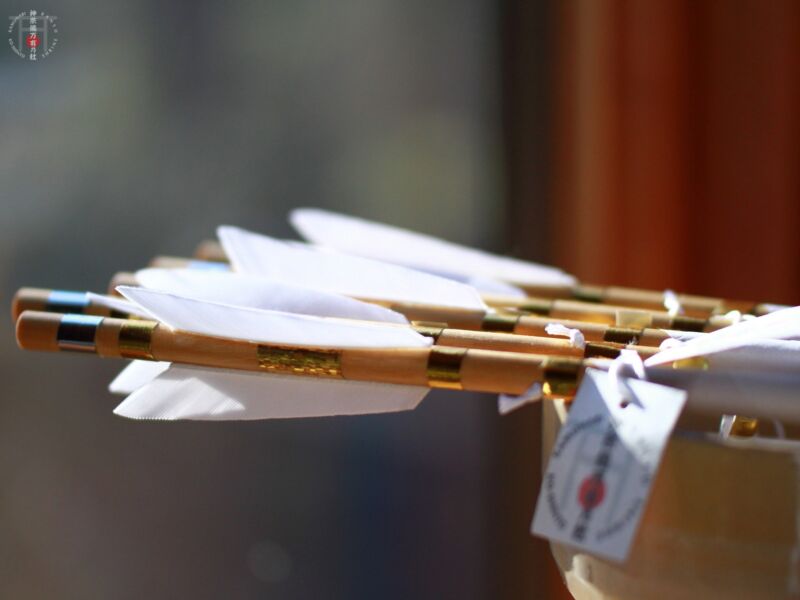
5) Since beginning your activities in the USA, what activities have you been involved with?
I have been involved with the same types of Shinto activities conducted in Japan but in a more international way, both large scale conventions/festivals to private scale. These have included various kinds of ceremonies, many kinds of Ko-Shinto/Shinto lectures/workshops, Misogi-Harae purification practices, other Ko-Shinto gyouhou practices, Kagura Shinto theatrical sacred dance (both performance and giving classes), offering amulets, and so on. There are so many, so please refer to Kamunabi Ban’yu Ko-Shinto shrine facebook page or my website.
https://www.atelierkanawa.com/shinto-ceremony
https://www.atelierkanawa.com/shinto-talks-lectures
https://www.atelierkanawa.com/kagura-shinto-dance
https://www.atelierkanawa.com/amulets
In response to Covid-19 pandemic situation, I have also developed virtual Misogi-harae purification, as well as virtual ceremonies. It was quite a discovery to find out that many people participated from all corners of the world. I would like to deliver all of you these highlights videos of Ko-Shinto style ceremony from Nagoshi-no-Ooharae Summer Great Purification which has an English-language MC. Please read the description as well, as this ceremony was combined with Covid-19 related special prayers. I hope watching them encourages you spiritually during this pandemic.
Nagoshi-no-Ooharae with Covid-19 related Special Prayers Highlights 1. https://youtu.be/aGKOZ4En0Og
Nagoshi-no-Ooharae with Covid-19 related Special Prayers Highlights 2. https://youtu.be/cQZf37K6F-o
I hope everyone will also enjoy Kamunabi Banyu’ Ko-Shinto Shrine channel which irregularly uploads ceremonies, Kagura, Misogi, lectures and so on.

